Chapter 8 The Human Body Heart
Have you observed where a Doctor places his stethoscope on the chest of a patient to hear the heart sound?
If you put your hand on the chest of your friend who has just completed running events in school sports. What you will feel if you place your ear in his chest, you will hear the ‘lub-doub’ sounds of the heart (heart sounds) and it come more or less from the left side of the chest.
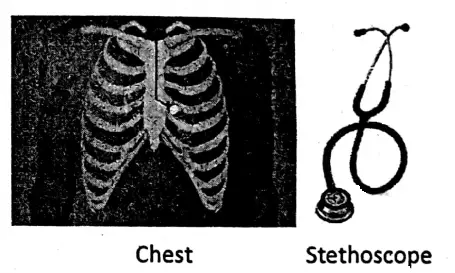
This active organ is one of the most vital organs of our body and is called ‘the heart’. It is the main organ of blood circulation of our body. Make a hand-made stethoscope or you may get it from your school laboratory (Biology Department).
“WBBSE Class 6 General Science Chapter 8 the human body notes”
Try to understand the location of the heart in the human body and complete the table. If necessary take help from your teacher.
Read and Learn More WBBSE Notes For Class 6 General Science and Environment
Tick in the proper place :
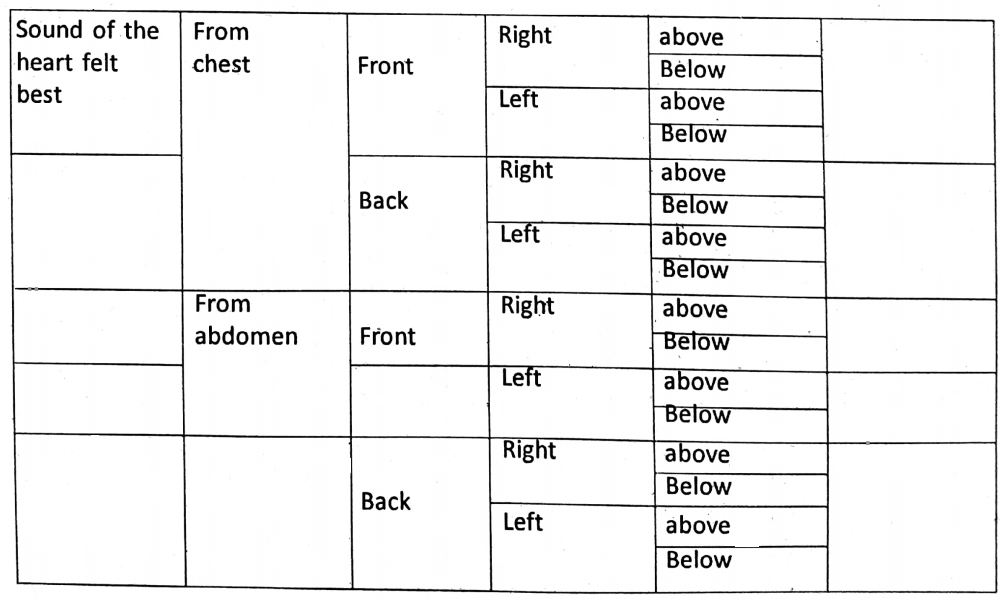
Chapter 8 The Human Body Location Of Heart
Location Of Heart:
The heart is well covered in our body. It is protected by the rib cage by the sternum (the middle place where ribs meet together) from the side and front and back by the vertebral column (made up of hard bony vertebrae).
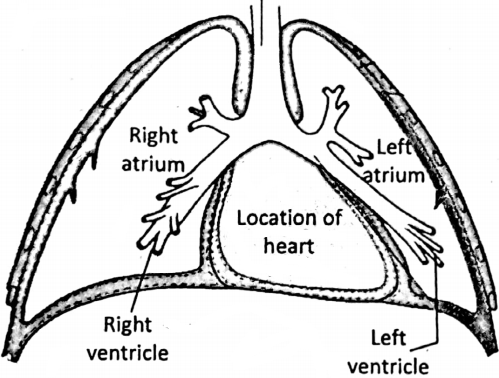
The heart is located in a thoracic cage (cavity) between the sternum and vertebral column. The largest part of the heart is situated in the left half of the thoracic cavity.
What is the heart?
The heart is the pumping mechanism of the body. It is a hollow, muscular cone-shaped organ. It is the main organ of blood circulation. The weight of the heart is about 300 grams.
| Class 6 History | Class 6 Social Science |
| Class 6 Geography | Class 6 Science |
| Class 6 Maths | Class 6 Science MCQs |
| Class 6 General Science | Class 6 Maths Solutions |
| Class 6 Geography | Class 6 Hindi |
It may be compared with a two-storied house with two rooms on the ground floor and two on the first floor. The first floor or the upper part of the heart (apex or anterior part) has two chambers (rooms) and the ground floor or lower part (base or posterior part) also has two chambers (rooms).
“WBBSE notes for Class 6 Science the human body”
=
Therefore, the human heart has four (4) chambers, two in the upper part and two in the lower. The upper chambers are called the atrium or auricle and the lower chambers are called the ventricles. The walls of the ventricles are thicker than the auricles.
The blood continuously moves through the organs. This movement is called blood circulation.
Chapter 8 The Human Body Blood
The blood is red fluid salty, and alkaline in reaction.
The heart is enveloped (covered by) in a membranous sac called the pericardium. (the outer membrane of the heart) The blood flows through a narrow elastic tube-like structure, these are called blood vessels.
Blood vessels are of three types-
- Arteries
- Veins and
- Capillaries.
Arteries:
These are blood vessels through which blood flows from the heart to organs.
Veins:
These are the blood vessels through which blood flows from organs to the heart.
Capillaries:
Are minute blood vessels. They are found between small arteries and veins.
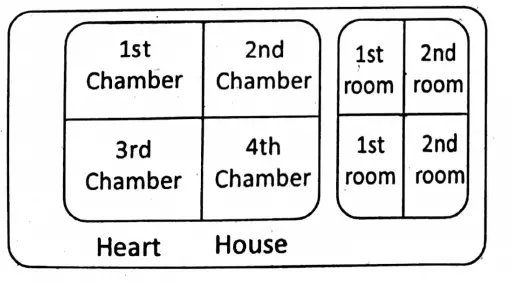
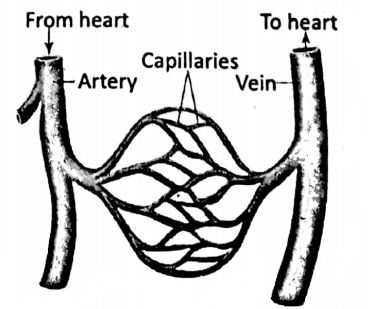
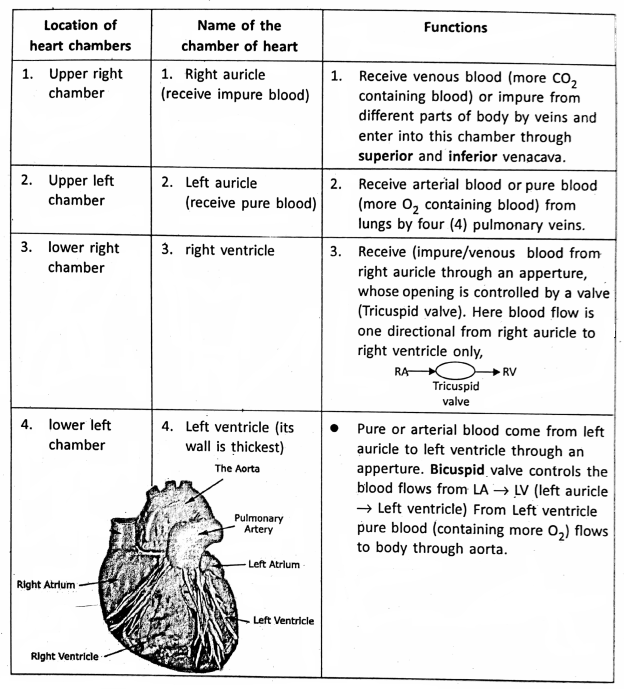
- Blood purifies in the lungs.
- Impure blood reaches the lung through the pulmonary artery. After purification pure blood
- Again comes to the heart (left auricle) through the pulmonary vein.
- Blood flows fromthe right ventricle to the lungs through the pulmonary artery.
Usually, the artery carries pure blood (more oxygenated blood) and the vein carries impure blood (less oxygenated blood). But the pulmonary artery carries impure blood and the pulmonary veins carry pure blood.
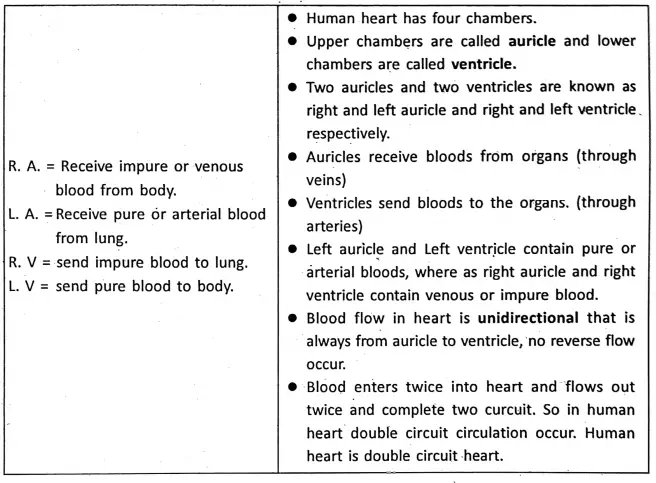
The left ventricle of the human heart is the largest chamber and it is the most powerful chamber too. This is to exert more pressure which helps to send pure blood to the aorta.
All these events which you have just read do not happen one by one. Blood enters simultaneously to the right and left auricles and similarly, blood passes to the right and left ventricle simultaneously from the right auricle and left auricle respectively.
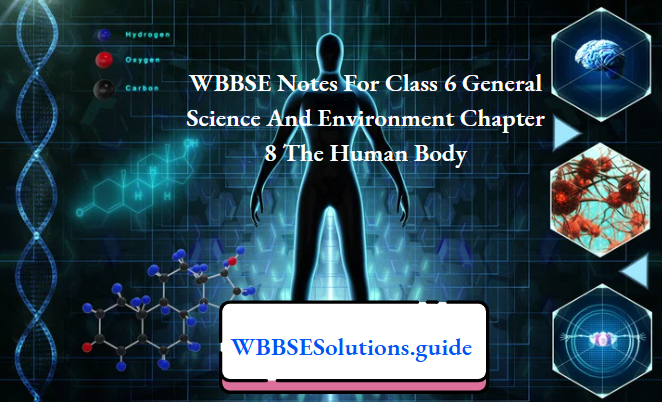
Similarly, blood flows out from the right and left ventricles to the lungs and body respectively simultaneously. The work of the heart consists of rhythmic contractions (reduced size) and relaxations (expands) of auricles and ventricles.
The heart’s contraction is called systole and the relaxation is called diastole. The contractions and relaxations of the different parts of the heart take place in a definite order.
- In the simultaneous contraction of both auricles, blood passes from the auricle to the ventricle.
- Simultaneous contraction of both ventricles → blood flows out of the heart.
- During the relaxation of auricles and ventricles → blood enters into these chambers.
The work of the heart gives rise to sounds known as heart sounds. They may be heard by putting an ear directly to the chest or by means of a special instrument, stethoscope or phonendoscope.
Heartbeat
Heart always in move it. expands and contracts. Each expansion (diastole) and contraction (systole) consists the heartbeat.
Heartbeat:
Pulsation of the heart including one complete systole and diastole.
Pulse is the result of the rhythmic contractions of the heart.
Pulse And Pulse Rate
Pulse rate is the number of times a person’s heart beats per minute.
The normal pulse rate may vary from 60 to 80 beats per minute in rest. In children, the pulse rate is faster. The average pulse rate of an adult is 72 per minute (72 beats/minute).
Try to check your pulse rate and your friends or family members and make a table. The pulse rate depends on various conditions. A person’s pulse is often felt through the arteries (radial artery) on the wrist.
“Class 6 WBBSE General Science Chapter 8 human body explained”
You can measure the pulse rate by pressing the radial artery (superficial artery underlying bones) with two fingers (fore and middle) by your opposite hand.
Besides the wrist, you can take your pulse inside the elbow, at the side of your neck (cardiac pulse) or on the top of your foot. You can also take your pulse at your groin behind your knee and on the temple.
Complete the Worksheet
Examine the pulse of different persons:
| Name | sex | age | Pulsebeats per minute | Remark on condition resting/working | |
| Pluse beat | per minute | ||||
| 1. | |||||
| 2. | |||||
| 3. | |||||
| Pulse checking points of the body | Pluse per minute | Remarks |
| 1. Wrist | ||
| 2. Neck | ||
| 3. | ||
| 4. | ||
| 5. |
Chapter 8 The Human Body Measure your Pulse
Tracking your pulse is easy. You can do it on your wrist or neck. Little press with (lay) your index (2nd) and middle finger (3rd) on the inside of your wrist below the base of your thumb (between the bone and the tendon on the radial artery).
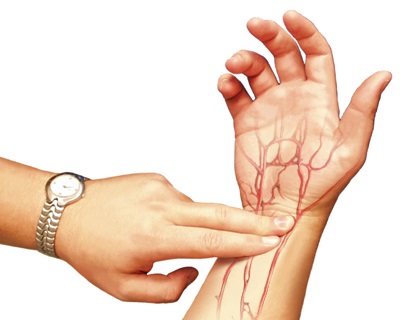
The spot over the radial artery. When you feel the beat, count the beat for 15 seconds (with a watch or stopwatch). Multiply the count by four to calculate the number of beats per minute.
Calculation :
Suppose you count the number of beats in 15 seconds as 18 then the pulse rate per minute is (pulse rate)
18 x 4 = 72 beats per minute.
Pulse rate depends on the physical condition of the person concerned. Take the pulse rate of your friends in different conditions and compare it.
| Name | Age | Sex | Physical condition | Remarks |
| 1. | 1. Sitting in the School bench | |||
| 2. After working such as stair Brealey | ||||
| 3. After running | ||||
| 4. Lying in bed. | ||||
| 5. After a sports event |
Don’t do this if your friend or the person is not fit or ill
Chapter 8 The Human Body Problem Of Heart
You will find some people who are suffering from heart disease. You may head some students who have a hole in their heart. Let’s see some of the common heart problems.
Sometimes there are defects (problems) in the walls of the heart like holes in the heart or to the valves (valves may be too narrow or partially or completely blocked) which means either blue (venous) blood or red blood (oxygenated) gets mixed up or the heart may not pump very well.
These show some symptoms like-
- Blue baby-blue skin and blue around the lip.
- Difficulty in feeding.
- Shortness of breath.
These symptoms are usually due to a reduced supply of oxygen to the body. If you find someone around you with this problem you must convey the message to your parent, teacher, and doctor you know.
Sometimes you may hear pacemaker has been fitted to some person’s heart. It is an artificial treatment for irregular heartbeat. Sometimes blood flow in heart muscles (cardiac muscles) is hampered.
“Step-by-step notes on the human body Class 6 WBBSE”
In some cases, heart muscles do not work properly, and the person feels chest pain, breathing problems, and sweating profusely. This a serious problem of the heart. In this case, the patient must be hospitalized.
There are many different types of heart diseases. Some are congenital (people born with heart problems) but the majority of heart diseases develop over time and affect people later in life.
Some Heart diseases are
- Coronary artery disease
- Silent ischemia
- Angina
- Arrhythmia
Some common symptoms of different types of heart disease:
- Discomfort.
- Chest pain that radiates to the shoulders, neck, or arms.
- Shortness of breath.
- Profuse sweating.
- Nausea and vomiting.
- Rapid heartbeat.
- Severe weakness.
You should advise a person who is facing a few of these symptoms should go to a doctor or health center for a check-up.
Chapter 8 The Human Body Blood Pressure
It is the pressure of circulating blood on the walls of blood vessels. Normal human blood pressure is 120/80 mm Hg. (systolic pressure 120 mm /Hg, diastolic pressure 80 mm/Hg)
Blood pressure is measured by a special instrument known as Sphygmomanometer.
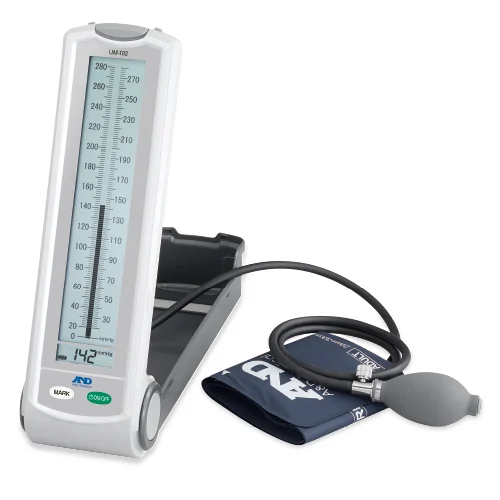
All of you have seen blood. Many of you may have tested it. You have already learned that blood is a red-coloured fluid salty in taste and alkaline in nature. Blood is one of the most important fluids of the body.
It is a connective tissue that delivers necessary substances such as nutrients (food substances) and oxygen to the cells and brings back carbon dioxide from cells.
It transports metabolic waste (waste products) from the cells and transfers these into the liver and kidney.
Chapter 8 The Human Body Composition Of The Blood
The major constituent of blood is water, the watery part of blood is known as plasma. Plasma is viscous, slightly yellowish fluid, 55% of blood is plasma. Plasma consists of 90- 92% water and 8-10% organic and inorganic substances.
The greater part of organic substances are protein-like albumins, globulin, and fibrinogen. It also contains glucose, fat, and waste products like urea, and uric acid. Plasma also contains different mineral salts, vitamins, etc.
“WBBSE Class 6 General Science Chapter 8 important questions and answers”
Other components of blood are different types of blood cells (45%). As the plasma is a watery substance it helps the blood to move through the thick and thin channels (blood vessels) from one part to another.
Most of the carbon dioxide is carried by the blood plasma.
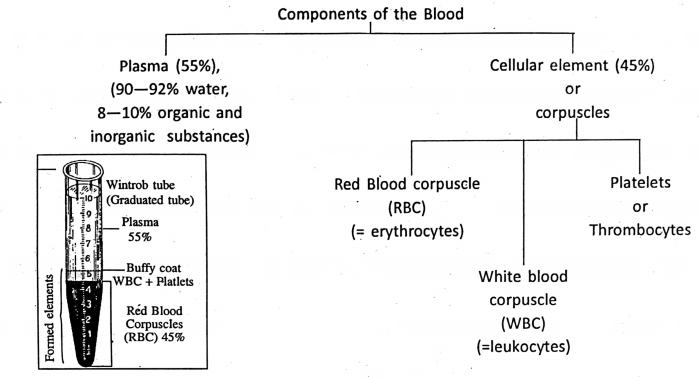
1. Red blood cells or Red blood corpuscles (RBC) :
They are flattened disc-like structures, that transport oxygen (O2) to different parts of the body. RBCs are not visible to the naked eye (microscopic).
They are red due to the presence of the pigment hemoglobin, which helps to carry O2 and CO2. blood plasma. Most of the O2 carried by Most of the CO2 is carried by the hemoglobin of RBC.
2. White blood cells or white blood corpuscles (WBC) :
WBCs are white and have a nucleus. They are also not visible to the naked eye. They are also very important. They perform a protective function. WBCs fight with the microbes that attack our body and in most cases, they engulf (eat) and destroy bacteria and other microbes.
3. Blood platelets or thrombocytes :
Besides RBC and WBC there are some very small irregularly shaped particles in the blood, these are called platelets or thrombocytes. They help the blood to coagulate (blood clotting) when there is a cut in the body.
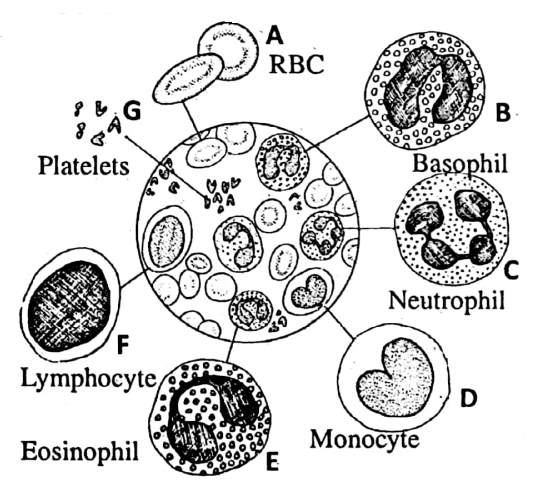
Besides this blood contains many other things such as hormones, enzymes, different foreign bodies, toxins, etc. Blood try to balance its components but when it does not work the imbalance will cause problems. Then we may have to go to the doctor for a check-up.
Make a table with different components of blood
| Component of blood | Function |
| 1. Plasma | |
| 2. RBC | |
| 3. WBC | |
| 4. Platelets | |
| 5. Other components of plasma |
Why does blood clot?
When you cut your finger, it starts to bleed, but after some time, the bleeding stops. This is because your blood contains special substances that make the blood clot.
Platelets, fibrinogen (a protein present in plasma), and some chemicals take part in blood clotting. After some chain chemical reaction platelets dump together and form a plug which reduces bleeding.
Chapter 8 The Human Body Effects Of Fight Of Blood With Microbes
Every day various types of disease-causing microbes enter our bodies. But they are always not able to cause diseases.
Why all time we not get sick ?
Because the body has its own defense mechanism which destroys many microbes once they enter into the body. Body defense includes physical and chemical barriers that are always ready and prepared to defend the body from infections.
The first line of body defense includes our skin, tears, mucous, cilia, stomach acid (HCI), urine flow, friendly bacteria, and WBC. Natural barriers and the immune system of the body defend against organisms (microbes) entering in to our body.
When our eyes are infected by microbes, (bacteria or viruses) such as conjunctivitis (by a virus) thick white fluid or puss comes out of our eyes.
You may have noticed eyes discharge at the corner of your eyes or in the eyelids. Eye discharge is usually thicker and pus-like yellow, green or even grey in colour.
Personal hygiene, thorough washing of eyes with clean water. Not to touch your eyes without cleaning your hands and with contaminated clothes. It is to necessary to take the advice of a doctor as soon as possible.
“Solved examples of the human body WBBSE Class 6 Science”
You may have noticed that yellowish or whitish or brown-yellow pus (liquor purine) discharges from old wounds or boils pus is a protein-rich fluid filled with dead WBC (leucocytes) that fight against microbes.
When the buildup is on or near the surface of the skin it is called a pustule or pimple. An accumulation of pus is on enclosed tissue space is called an abscess.
Thick discharge of mucus may be an indication of infection of fungus or other microbes. Besides blood, some other substances are present or secreted in different parts of the body which also protect the body from harmful microbes.
When bacteria (microbes) enter the body through the eyes, nose, mouth, cut or bruise or even with food there are different mechanisms like blood to kill the microbes.
Different things besides blood help to kill microbes
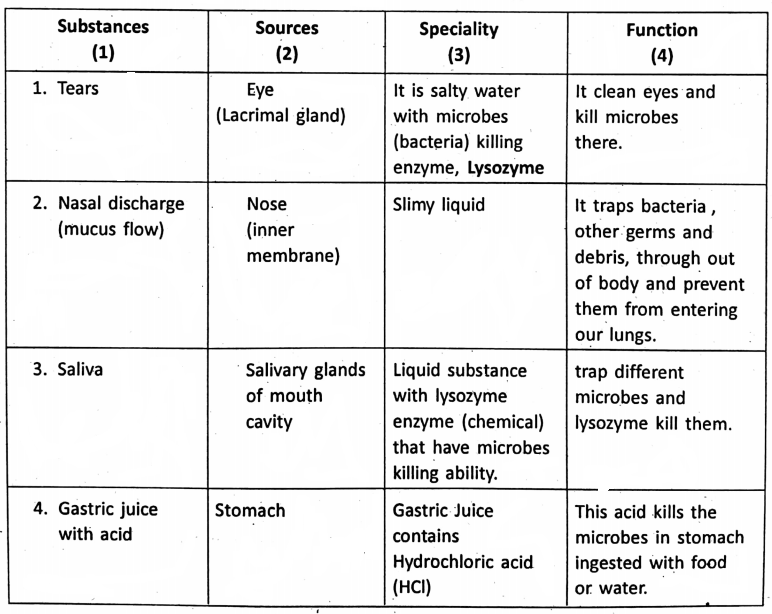
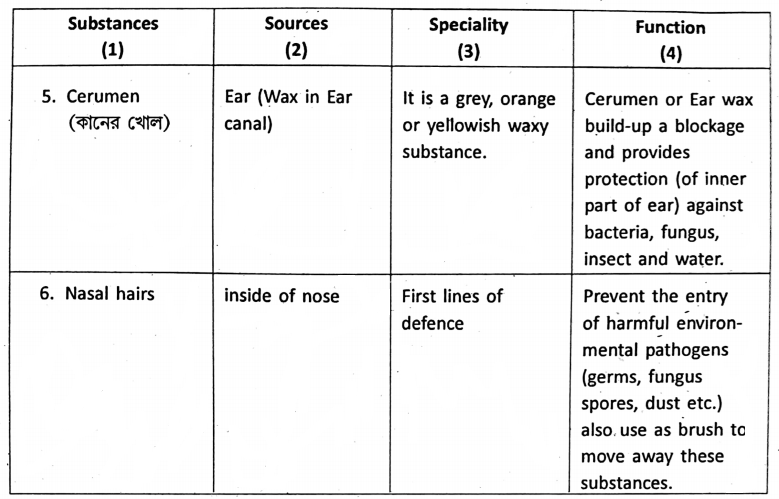
To improve body defense against germs we need to follow the following guidelines
- Maintain healthy diet
- Maintain cleanliness of body and dresses.
- Maintain regular exercise.
- Skin care because the skin is one of the most important first lines of defense against microbes.
- Behavioral change according to need.
Complete The Table
Make a list of entry points of germs in our body.
| Organ/things | Place / Location / Cause |
| 1. Head and face | 1. Mouth (Mouth aperture) |
| 2. Nose (Nasal apperture) | |
| 3. Ear | |
| 2. Skin | 1. Cut |
| 2. Dirty skin | |
| 3. Damage skin. | |
| 3. Mouth | Through food and water |
| 4. | |
| 5. | |
| 6. |
Make a list of preventive measures of the body (defense mechanisms)
| Name | Place | Role |
| 1. Hydrochloric acid | ||
| 2. Mucus discharges | ||
| 3. Saliva | ||
| 4. | ||
| 5. | ||
| 6. |
You may have faced some breathing problems in a crowded bus or train or in a less airy place. This is due to the inadequate amount of oxygen in air. There is a continuous interchange of gases between humans and the external environment (breathing).
We breathe approximately fifteen thousand liters of fresh air in a day. We have special apparatus for this purpose, that is, for respiration. The main respiratory organ of humans is the lung.
Other important associated organs are the trachea, bronchi, and bronchioles. The air (oxygen-mixed air) enters our body either through the nose or mouth and travels to the lungs through the windpipe (trachea) bronchi and bronchioles.
Lungs have about three hundred million tiny air sacs (alveoli) which are surrounded by fine blood vessels. Blood vessels absorb oxygen (O2) from air sacs and transfer oxygen to the blood.
“Best guide for Class 6 General Science WBBSE the human body”
=
At the same time, carbon dioxide (CO2) leaves the blood and enters into alveoli or air sacs and is thrown out through the same route during exhale. All of you know that oxygen is necessary for our survival.
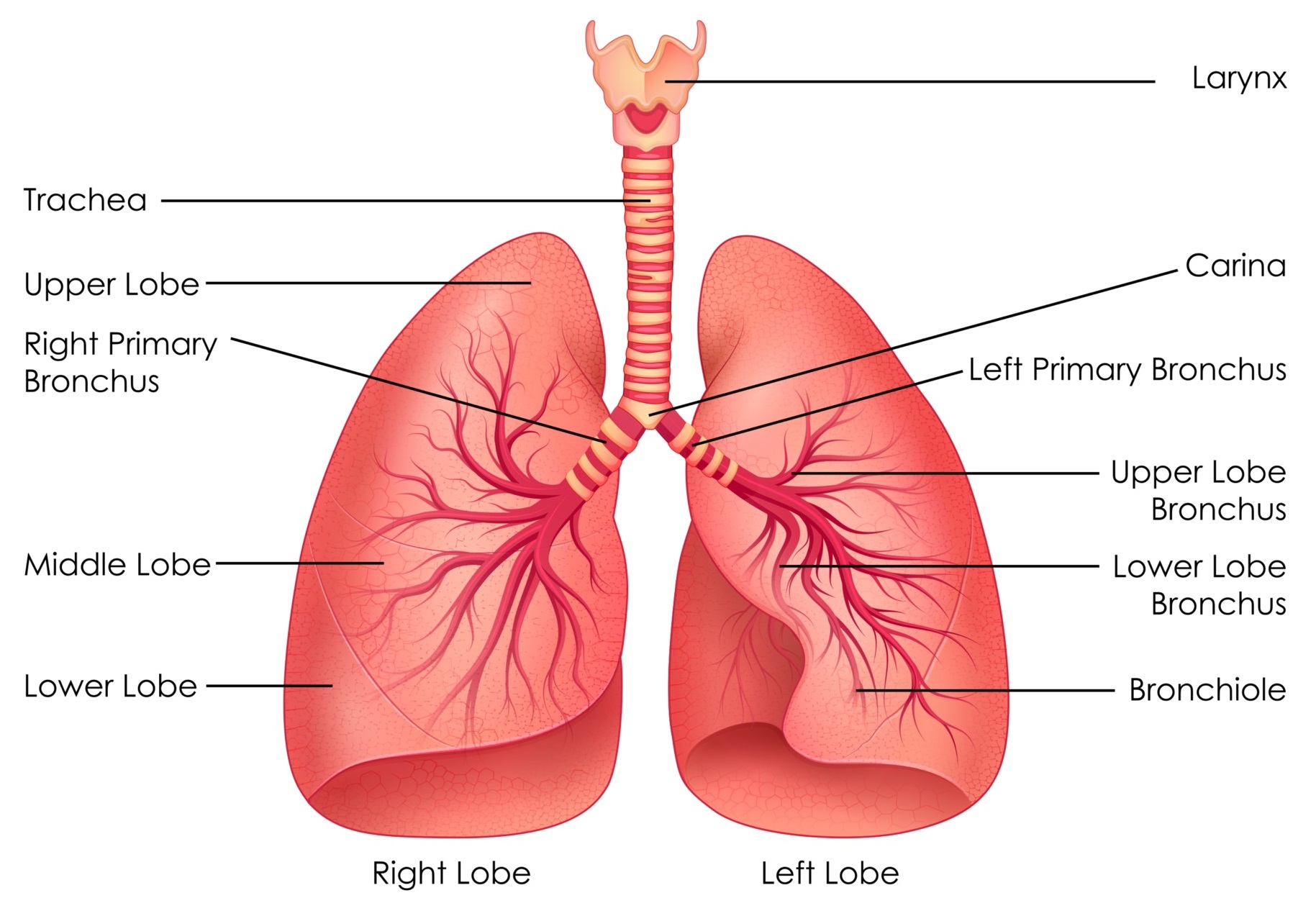
The air we breathe consists of oxygen with other gases. Atmospheric air contains nearly 21% (or 1/5) oxygen.’ After entering our body through respiratory organs oxygen reach different parts of the body (every cell) and burns the food there and releases energy from food.
We use this energy for our activities. The lung is the main respiratory organ of humans. Human has two lungs-right and left. The human lung is a bag-like structure, blackish pink in color. The right lung has 3 lobes and is bigger in size.
The left one is comparatively smaller and has two lobes only. Lungs are situated in the thoracic cavity. The windpipe or trachea divides into two parts. Each part is called bronchus (bronchi- pleural)
Two bronchi enter separately into two lungs. The branches of bronchi after entering the lung divide into numerous branches and sub-branches. These smaller branches of bronchi are called bronchioles.
Bronchioles ultimately end in small air sacs (balloon-like structure), alveoli. Each alveolus is covered with small blood vessels (capillaries).
“Understanding human body systems Class 6 WBBSE”
Trachea is internally supported by a half ring of cartilage (soft bone cartilage ring) that prevent the trachea and bronchi to being collapse completely during low air pressure.
Respiration is a physiological (biochemical) process in which food substances are broken down with the aid of oxygen and as a result carbon dioxide and water are produced and energy is released.
Normal respiration rate (breathing rate) for an adult person at rest range from 12 to 16 breaths per minute. In a relaxed state a man breathes approximately fifteen times per minute.
In both lungs of an adult, there are about 300 million alveoli (30 core)
The path-way of air passing in the human respiratory system.
Environment:
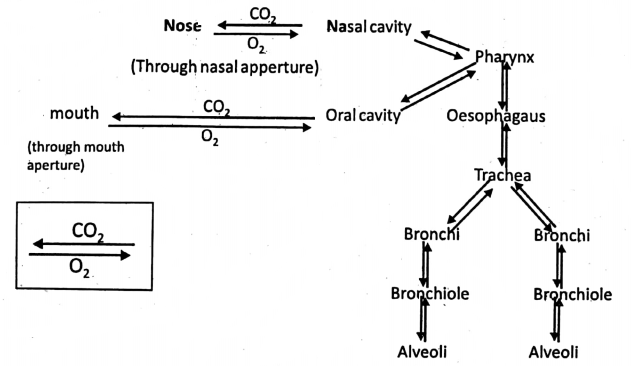
Chapter 8 The Human Body Breathing
Breathing is a mechanical process. It consists of two processes
- Inspiration-Taking in of air (oxygen) from the environment.
- Expiration-Giving out of carbon dioxide to the air.
Organ of Breathing:
Organs concerned with the process of breathing (external respiration) are wind-pipe (trachea) bronchi (branches from trachea), ribs and muscles between the ribs (intercostal muscles), and the diaphragm.
Diaphragm is a muscular membrane present between the lungs and stomach (between the thoracic and abdominal cavities)
Mechanism-How do we inhale and exhale?
- During inhalation or inspiration rib muscles and diaphragm contract, increasing the area of the thoracic cavity the cage in which the lung is placed with the increase of the thoracic cage lung expands, as a result, the atmospheric air enters in to the lungs.
- During exhalation or expiration, reverse cases happen. Rib muscles and diaphragm relax. The area of the thoracic cage (chest) decreases. As a result, lungs become compressed and air comes out from the lungs.
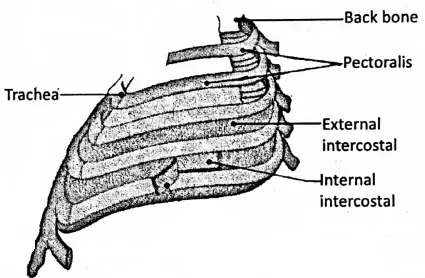
Chapter 8 The Human Body Lung Problems
Lung disease refers to disorders that affect the lungs.
Asthma:
Asthma is a disease that affects the breathing passages of the lungs. This makes breathing troubles.
COPD:
It is a type of obstructive lung disease characterized by long-term breathing problems.
Pneumonia:
the bacterial disease affects the lung.
Common symptoms of lung disorders include shortness of breath, coughing, noisy breathing, and chest pain, blood in the cough, etc.
- In some lung diseases like TB (Tuberculosis) blood comes with a cough.
- It is a bacterial disease. Lung cancer is also a dreadful disorder of the lung.
- If you find any such problem you should inform your parent, teacher, and physician.
Signs and symptoms of Lung disease TB (TB may occur in another organ too) Coughing that lasts for three or more weeks
- Cough with blood (blood in cough)
- Chest pain or pain with breathing or coughing. Weight loss, fever, night sweating, etc.
- In the later stage blood in coughed at regular basis.
- Asthma: Asthma is also a lung-related problem in which difficulty in breathing.
- Chest pain
- Cough and wheezing
- Rapid breathing.
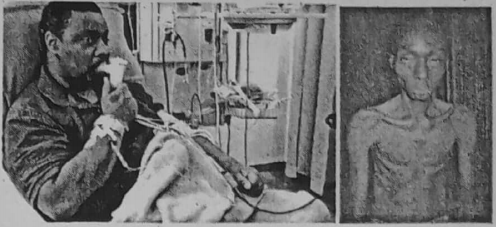
Chapter 8 The Human Body Bones Bone Joints And Muscles
Bones:
Have you ever observed any human skeletons? The human skeleton is composed of many short and long bones of different types. We can stand erect and walk straight because of the presence of bones.
At the time of birth, a baby has more than three hundred bones (approx 300) inside the body. (So their body is so flexible). With the passage of time as one grows some of the bones join together.
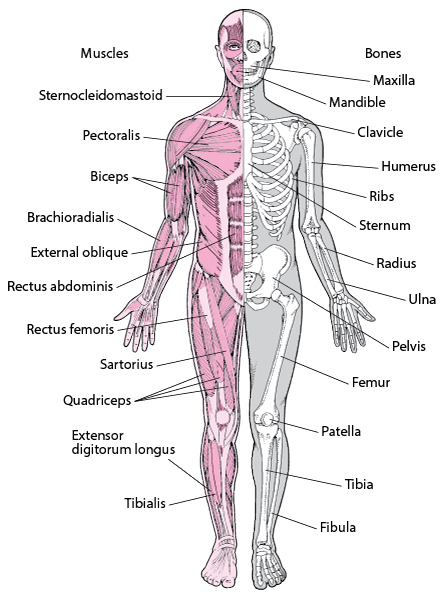
A fully grown adult has 206 bones. Nearly half of the total number of bones in a human body are located in the hands and legs (30 in each hand and leg). The thigh bone, which is known femur is the longest bone and the smallest bone is step is present in the ear (middle ear)
Touch and feel different bones of your classmate or try to see any pressure bone and complete the table-
| Parts of the body | No. of bones | Structure / How they look like | Position of the bones |
| 1. Finger | |||
| 2. Palm | |||
| 3. Wrist | |||
| 4. Hand | |||
| 5. Arm | |||
| 6. Legs 1. Thigh 2. Ankles 3. Feet 4. Finger of leg |
If you follow the central axis of (the 22 bones in the brain box) the skeleton (middle part) and skull is at the top made up of many differently shaped (22 bones) hard bones.
The skull ends with the upper Jaw, and lower Jaw attached separately below the skull Jaws bear the Position of the eye, Cranium (brain) teeth. Below the skull is the vertebral column or backbone. It consists of vertebrae short hard knob-like bones known as vertebrae.
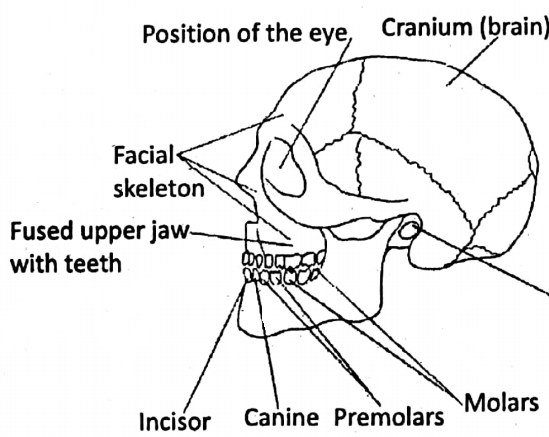
These are the bones that permit you to bend and twist your back. It also protects the inner spinal cord. Vertebrae of different regions of the vertebral column have some structural differences. In the chest region ribs (12 pairs) are present.
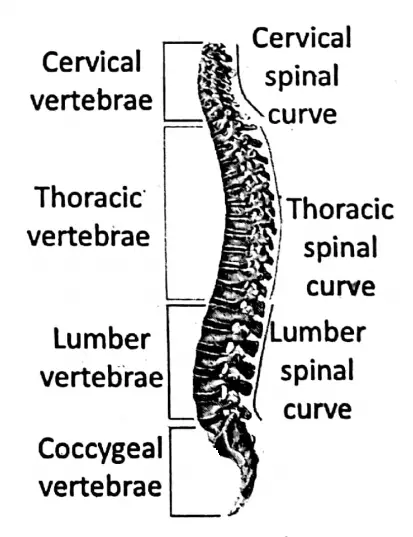
Ribs from both sides joint in the front side with the sternum and form the rib cage which protects many vital organs of the body like lungs, heart, etc.
- The skeleton performs functions of support, movement, and protection.
- Bone marrow is present inside the bones it produces blood cells.
Bones are called long, short, flat, and mixed according to their shapes. Long bones are found in the limbs-such as upper arm bone forearm bones, thigh bone, and shin bone.
Short bones are found in the wrist, ankles, and fingers. Flat bones are found in pectoral and pelvic girdles. eg. ribs, scapula. Mixed bones are present in the head.
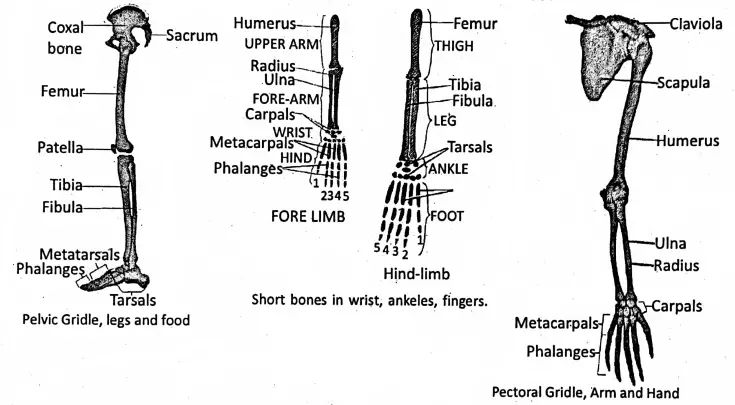
Make a list of different bones as their shape and size and mention their location
| Bones’ shape and size | Location | Remark |
| 1. | ||
| 2. | ||
| 3. |
How Are Bones Held Together
The bones are held together by means of tough strip-like structures known as ligaments.
Ligaments stretch across the joint and prevent bone from moving too far away in the wrong direction.
Tendon is a tough band of fibrous (connective) tissue that usually connects muscle to bone. A ligament is a fibrous connective tissue which attaches bone to bone.
The gymnasts exercise to stretch their ligaments for easy movements of their bones.
Orthopedic Problems
Dislocation of the bones:
Sometimes bone loses its location, this is called the dislocation of bone. For example, in the event of an accident, the head of the arm bone (humerus) which normally fits into the shoulder blade might be knocked out of its socket.
This knocking out of the humerus is a dislocation of the bone. The same case may happen in the femur and other joints also.

How are bones joints?
Bones joined with each other in various ways. The point at which two bones are joined together is known as the bone joint.
Type Of Joints
- Bone joints present in the skull are not movable. These are called immovable joints.
- Some bone joints are less mobile and have only a limited range of movement. These are called partly movable joints or slight movable joints. Example-Joints between vertebrae, hip joints, etc.
- Movable joint (or synovial joint) This is the type of bone joint in which some degree of free movement of bone is possible.
In this type of joint opposing bony surfaces are covered by cartilage (a type of elastic bone) and bones are held together by surrounding tubes like capsules. Ligaments are present on the outside of the capsule and synovial membrane inside.
“Functions of human body organs Class 6 WBBSE Science”
Within the synovial cavity a liquid, synovial fluid is present which makes the movement of bones easy.
Chapter 8 The Human Body Types Of Movable Joints
Pivot Joint (= rotary joint)
The joint between the first (atlas) and second vertebra (axis) of the vertebral column in our body. A truly movable joint that allows only rotary movement around a single axis. In this type of joint, the moving bone rotates within a ring that is formed from a second bone.
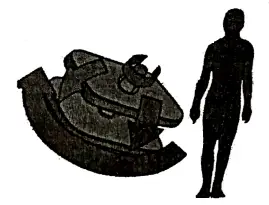
Ball And Socket Joint
A joint in which a ball (head of a bone) moves within a socket so as to allow rotary motion in every direction within certain limits.
For example hip and shoulder bones have this type of joint. Rotation of the head of humorous and femur within their respective cavities of joints.
Ligament: They attach one bone to another.
Tendon: Attach muscles to bone.
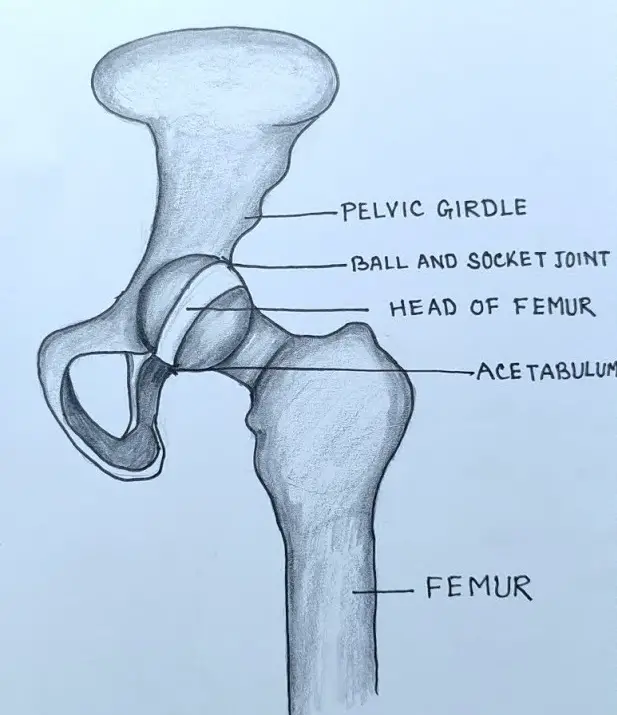
Hinge Joint
The wrists, ankles knee, and elbow joints have hinge joints. Hinge joints are formed between two or more bones where the bones can only move along one axis like the hinge of a door.
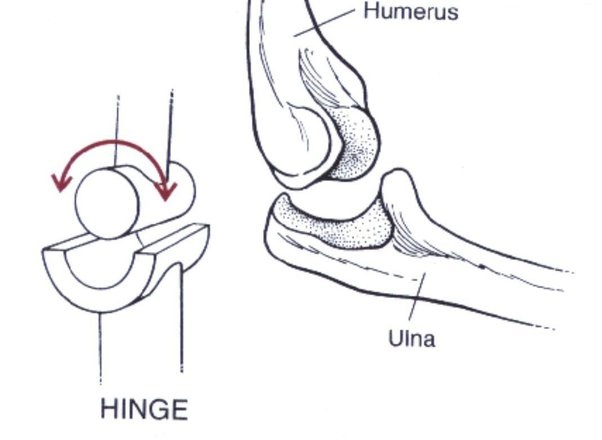
Saddle Joint
In a saddle joint, you can slide and hinge the bone in any direction (biaxial) allowing movement in sagittal and frontal planes. The joint at the base of the thumb is a saddle joint.
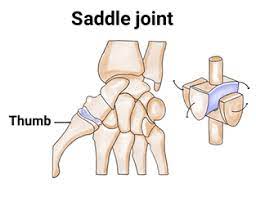
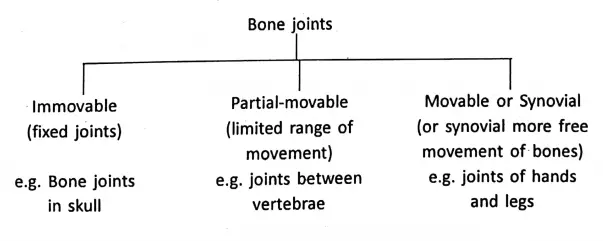
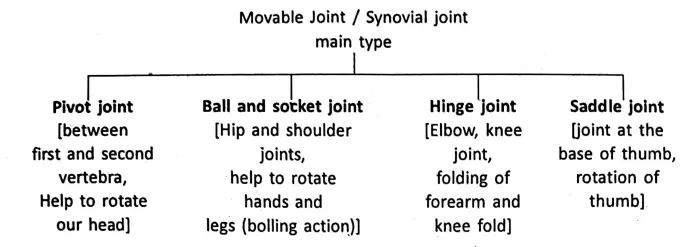
Complete The Table
Different bone joints their location and functions
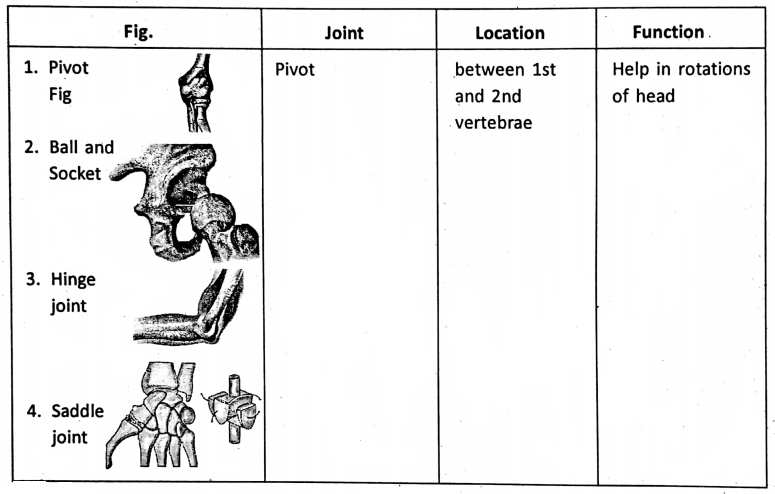
| Bone joints | Type of joint | Nature of joint |
| 1. between 1st and 2nd vertebrae | 1. Pivot | 1. Synovial or movable |
| 2. Rotation of the head of the femur in pelvic girdle | 2. | |
| 3. Joint in the skull | 3. immovable | 3. immovable |
| 4. Wrist joint | 4. | 4. |
| 5. Finger joints | 5. | 5. |
| 6. Joint between vertebrae | 6. | 6. |
Different Movements
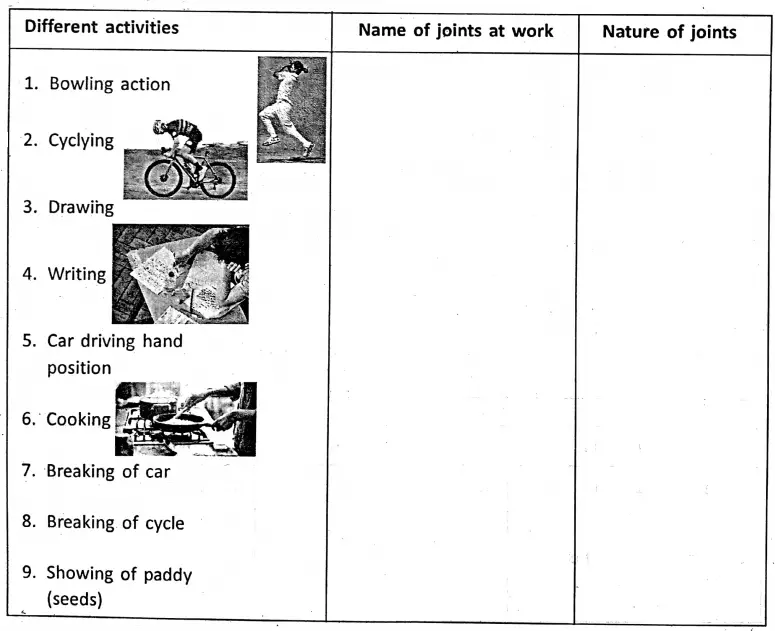
Chapter 8 The Human Body Problem Of Bone Joints
Calcium makes our bones hard. If our body does not get enough calcium and vitamin ‘D’ to support important body functions it takes calcium from our bones. This is called losing bone mass.
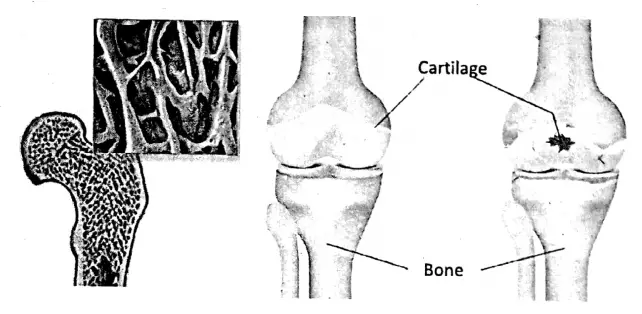
This increases the risk of bone disease and Osteoporosis (bones are weak and porous). Another common bone-related disease is Osteoarthritis. It is a degenerative disease of the joints usually accompanied by pain and stiffness. This degenerative disorder develops with age and affects walking.
“Different systems of the human body explained Class 6 WBBSE”
Gout:
When excessive uric acid, a type of waste product deposited in joints. Joints become swollen, reddish, and very painful situations arise.
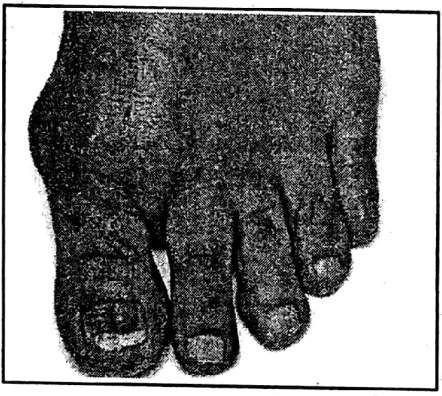
Back pains:
Back pain may be caused by a slipped disk or it may be associated with some disease of bones and joints.
Rheumatoid arthritis:
It is a chronic inflammatory disease affecting the connective tissue of the joints, pain, and stiffness in the joints. It usually begins with the joints in the finger spreading to the wrist, and elbows.
How do broken bones heal?
Although bone is a hard body part but during an accident or injury bone breaks. But the broken bone has the power to repair itself. Gradually new bone starts growing across the gap eventually.
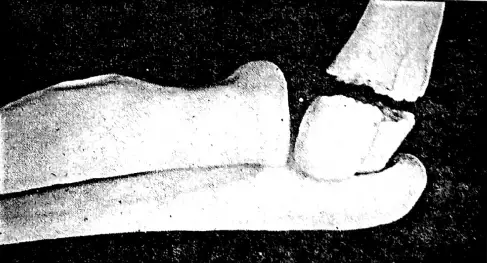
This new bone part hardens and unites the two broken ends. The doctor make plaster because the damaged part should not be moved. This helps to grow new bones without any difficulties and are united in the correct position.
Chapter 8 The Human Body Muscles
You may have seen a bodybuilder and may have seen a weight-lifter at least in Television. If you observe their body you may find different prominent muscles. Muscles grow bigger and better by exercise.
There are approximately six hundred and fifty muscles in the body. Each one of these muscles performs a particular task. For example, while walking, there are over two hundred muscles in action.
The muscle controls the bone to which direction it moves. The muscles are made up of packages of stretchable fibre-like material (myofibrils). These fibers are extremely slender (thin).
Each fiber is commanded by a nerve which makes it to contract. When muscles contract they do work.
Functionally all muscles are divided into two groups
- Voluntary (=striated) muscles-It contract by the w.I of man, example skeletal muscle.
- Involuntary (smooth) muscles-It’s contractions are not controlled by man.

For example, muscles are found in the walls of internal organs, and blood vessels.
Muscles attached with the bones (hands, legs, etc.) are called skeletal muscles. Muscles attached with the stomach and other internal organs are known as visceral muscles. (viscera internal organs).
Muscles of the heart are known as cardiac muscles. It is a special type of muscle. It is branched, involuntary, and usually never gets fatigued.
How do muscles work?
A tendon joins the muscle to a bone. The muscles can only perform one action and that is they can pull (contraction). In order to move a joint at least two separate muscles are required.
For example, the lower arm is raised when the bicep muscle (muscle present on the upper side of the arm) is contracted. In this state, the tricep muscles (muscles of the lower side of the arm) relaxed.
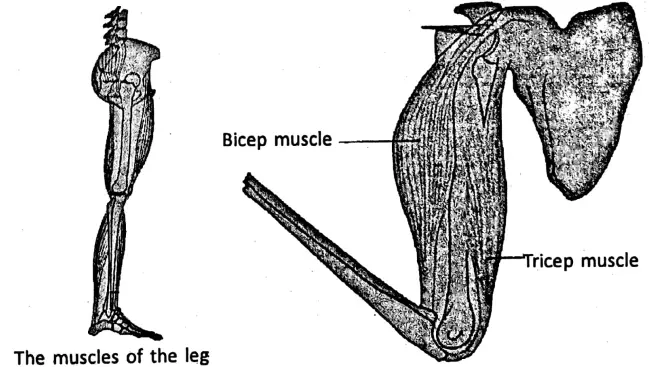
The arm can not be strengthened again by the biceps alone. It is done when the triceps pull the ulna down the biceps and then relax.
Ask your friend to fold his arm from the elbow. What you will see? Biceps muscle over the humorous swell. Press this part. You will feel hard then ask your friend to relax and lower his arm. Then see the length of the biceps muscle.
Make a table of your observation :
| The shape of muscle (working muscle) | muscles at the time of elbow folding | muscles at the time of relaxation |
| Length | increase/decrease | increase/decrease |
| Width | increase/decrease | increase/decrease |
| Stiffness | increase/decrease | increase/decrease |
| Nature of Job | The nature of muscles involve |
| 1. Movement of Jaw | |
| 2. Peristalsis movement or movement of the Alimentary canal. | |
| 3. Movement of the tongue | |
| 4. Holding somethings | |
| 5. Climbing | |
| 6. Swimming | |
| 7. Talking. | |
| 8. Opening and closing of eyes | |
| 9. Rhythmic contraction of the heart |
What is a muscle cramp?
You may often hear the case of muscle cramps of players. A cramp is an involuntary action that is a painful contraction of a muscle. It occurs when a muscle suddenly contracts unexpectedly.
It is usually a very painful state and remains for several minutes. Muscle cramps usually occur in the feet and hands. Sometimes it occurs in leg near the knee (calf muscle).
Problems Of The Muscles
You may have seen some people who is unable to move his/her lower body parts since birth. Legs and hands are slender. Many of you and your friend and family members who use computers often face some problems in fingers and neck.
During old age, people can not walk properly, and sometimes may not be able to stand erect, due to weakness of muscles. You may have found many office workers who has been having neck and back pains.
These area-related muscles are not working properly due to overaction. After proper exercise, this pain can be relieved.
The Growth And Development Of The Human Body
Most of you have noticed a newborn baby and a four-month-old baby. (1 to 3-month baby). You must have also observed that they have soft, small, slender arms and legs, fingers are short, slender, and have no or little strength.
All of us have passed this phase during starting of our life but as the advancement of age, our body gradually develops and gain strength. With the advancement of age, height and weight increase. Let’s see some examples and complete the table.
| Name of the organs /Parts of the body | Functions |
| 1. Hand and Finger | 1. To hold something, used during swimming, most of the work such as writing, throwing, etc. |
| 2. Legs | 2. |
| 3. Knee | 3. |
| 4. Teeth | 4. |
| 5. Shoulder | 5. |
| 6. Ankle | 6. |
| 7. Lips | 7. |
| 8. Tongue | 8. |
Every living organism requires food. We also require it for our survival maintenance of health, growth, and development. You have noticed with the advancement of age, a person’s body develops.
Proportionate development of different parts (organs) of the body occurs. Diet is the kind of food on which a person or a group lives. There are various components of food such as carbohydrates, fat, proteins, minerals, vitamin, and water.
Each of these components has a specific role in body formation. Good dietary habit gives us sound health and good mental development.

If you do not get sufficient food in day or day after day your body would not grow as well as the development of mental growth would also be hampered.
Chapter 8 The Human Body Work To Do
Complete the list by taking measurements of a different person as mentioned below. Some data has been provided. You have to complete the list.
From this table, you will get a picture of the measurement of different parts of our body (organs).
| Age of the person | Height (cm) | Weight (kg) | Name of different parts/organs of body Measurement (cm) | Proportionate measurement of the head, hand body, leg. | |
| 3-years | 94-95 | 14 | Head | 46-7-50-7 | |
| Head | 15-17 | ||||
| Body | 12—13 | ||||
| Leg | 20-23 | ||||
| 6-years | 112-113 | 20-22 | Head | 49-50 | |
| Head | 50-51 | ||||
| Body | 40-41 | ||||
| Leg | 65 | ||||
| 9-years | 132 | 31 | Head | 51 | |
| Head | 59 | ||||
| Body | 51 | ||||
| Leg | 72 | ||||
| 12-years | 149-150 | 40-41 | Head | 51 | |
| Head | 66 | ||||
| Body | 56 | ||||
| Leg | 93 | ||||
| Name of the student | Class | Sex | Weight | Height |
| 1. | ||||
| 2. | ||||
| 3. | ||||
| 4. | ||||
| 5. | ||||
| 6. | ||||
| 7. | ||||
| 8. | ||||
| 9. |
Categorization of Weight of different student
| Number of Students | Less than 30 kg | 30.5-32.5 (30-32 kg) | 32.6-34.5 (32-34 kg) | 34.6-36.5 (34-36 kg) | 36.6-38.5 (36-38 kg) | 38.6-40.5 (38-40 kg) | 40.5-above (40-above) |
|
|
From this table, you would get the average weight and height of students of your class. You may notice some has abnormal length and weight. They may be shorter or longer than average as well as some may be underweight and some are over weighted.
| Normal Height | Short height (dwarfism) | Long to very long (Gigantism) | |
| Male | Female | ||
|
|
|||
| No. of students | Normal Weight | Under Weight | Over weight (Obese) | |
| Male | Female | |||
|
|
||||
Chapter 8 The Human Body Abnormal Development
In the human beings, abnormal development can occur due to some chemical factor (hormone), hereditary or disease-related causes.
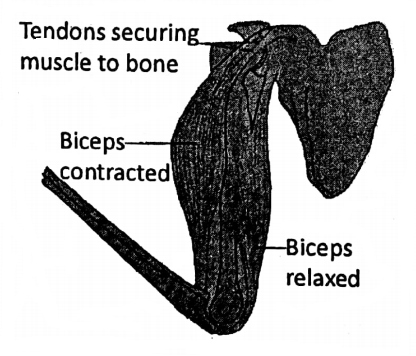
Three major functioning groups of food.
- Energy-producing food- carbohydrates,-Fat
- Bodybuilding Food of balanced diet
- Protective Food Minerals, vitamins, water
Some Deficiency Diseases
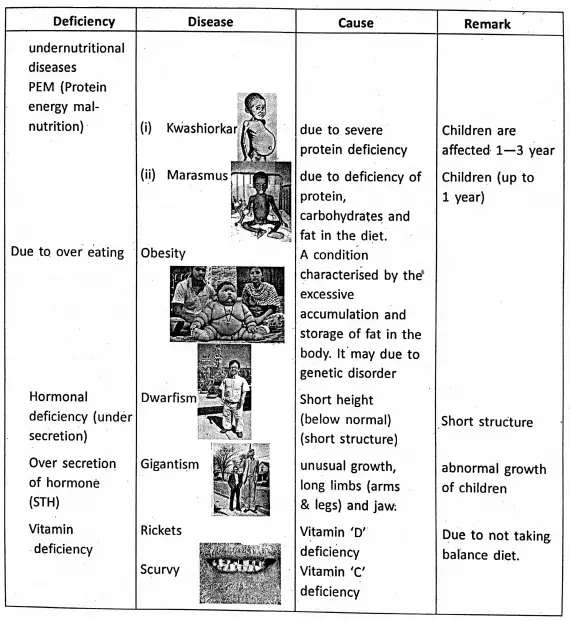
Before the start of puberty at the age of 10 there is not much difference between in growth ratio between boys & girls. (about 5 cm per year). Growth rate changes during puberty. In the onset of puberty in girls usually starts at around the age of 10.
“WBBSE Class 6 Science human anatomy and physiology notes”
Girls on average start their growth between the age of 10 and 14, about a year before boys. The average boy starts his growth at the age 12. Besides the above-mentioned deficiency disorder some other types of illnesses you may notice among students.
In the following table, a few of them and their probable reason are mentioned.
| Name of Illness | Cause of reason of illness | |
| 1. | Broken corner of the nail | Deficiency of calcium and some toxic effects of fluoride. |
| 2. | White mark on teeth | Toxicity of fluoride. |
| 3. | Fadeness of the corner of the eye | Deficiency of iron, vitamin B, and protein. |
| 4. | Color of skin | Malnutrition and deficiency of protein. |
| 5. | Ulcer at the corner of the lips and tongue | Deficiency of vitamin B. |
| 6. | Swollen gum and profuse bleeding | Deficiency of vitamin C. |
| 7. | Change of shape of the bone | Deficiency of calcium, protein, and vitamin D. |
| 8. | Frequent breaking of bone | Deficiency of calcium. |
| 9. | ||
| 10. |
Chapter 8 The Human Body Work To Do
After careful observation, you make of table (considering all these disorders) of your classmates.
| SI. No. | Name of the ‘ students | Class | Sex | Observation | Remark |
| 1. | R. Das | VI | M | Swollen gum relish blood appears sometime | Vitamin ‘C’ deficiency, need to take citrus fruits |
| 2. | ………… | ………… | ………… | ………… | ………… |
| 3. | ………… | ………… | ………… | ………… | ………… |
Body Mass Index
The Body Mass Index (BMI) ( Quetelet index) is a value derived from the body mass (weight) and height of an individual. BMI can be measured by dividing the body mass (weight) by the square of the body height.
“How do human body organs work? Class 6 WBBSE Science”
Its value indicates a health condition either person is under-weight, or mal or overweight or obese. Body mass index is a simple calculation using a person’s weight and height the formula is

Simply divide your weight in kilograms (kg) by your height in square meters. Example-Suppose the height of a student is 1.2 metres and weight is 38 kg. How can you calculate the body mass index (BMI) of that student?

Now check the scale of BMI and make remarks
Importance Of BMI
It is an indicator of whether a person’s weight is low, normal or over normal. Being overweight causes different physiological problems such as disease of the heart, bones, and liver. A person can be cautious about BMI and can take steps accordingly.
“Important facts about the human body Class 6 WBBSE”
Scale of BMI
BMI less than
15 =excessively low weight
16-18.5 = low weight
18.5-25 = Normal
25-30 = Heavy weight
30-40 = Excessively heavy
40 above = Obesity
The growth rates of girls and boys are slightly different. The growth rate of the girls increases in the age group of eight to twelve or thirteen.
WBBSE Notes For Class 6 General Science and Environment
-
- Chapter 1 Interdependence of Organisms and the Environment
- Chapter 2 Phenomena Around Us
- Chapter 3 Element, Compound and Mixture
- Chapter 4 Rocks and Minerals
- Chapter 5 Measurement
- Chapter 6 Primary Concept of Force and Energy
- Chapter 7 Statics and Dynamics of Fluid
- Chapter 8 The Human BodyChapter 9 Common Machines
- Chapter 10 Biodiversity and its Classification
- Chapter 11 Habits and Habitats of Some Important Animals
- Chapter 12 Waste Products
